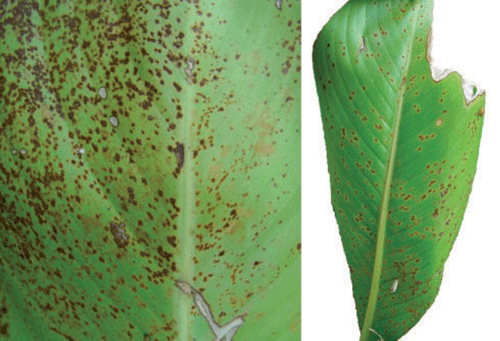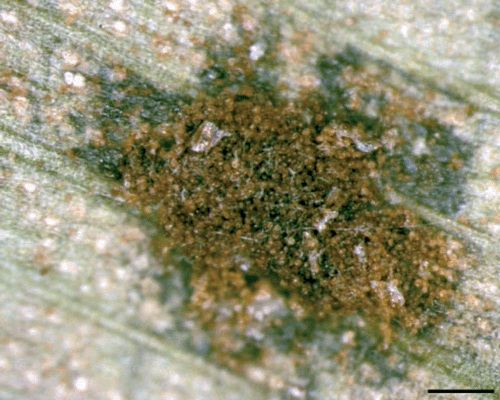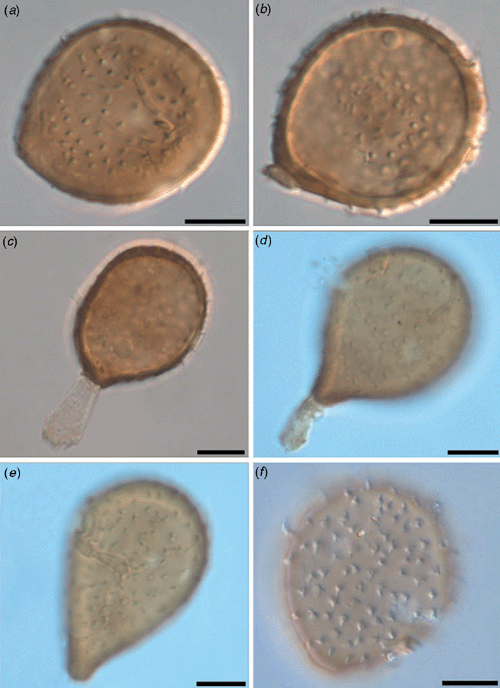Puccinia heliconiae on Heliconia sp. in Papua New Guinea
J. R. Liberato A B E , J. D. Ray C and T. Gunua DA Herbarium BRIP, Queensland Department of Primary Industries and Fisheries.
B Present address: Department of Regional Development, Primary Industry, Fisheries and Resources,Diagnostic Service Division, GPO Box 3000, Darwin, NT 0801, Australia.
C Australian Quarantine and Inspection Service, NAQS/OSP, 1 Pederson Road, Marrara, NT 0812, Australia.
D National Agriculture Quarantine and Inspection Authority, PO Box 741, Port Moresby NCD, Papua New Guinea.
E Corresponding author. Email: jose.liberato@nt.gov.au
Australasian Plant Disease Notes 3(1) 132-134 https://doi.org/10.1071/DN08051
Submitted: 15 June 2008 Accepted: 17 September 2008 Published: 9 October 2008
Abstract
Puccinia heliconiae is reported for the first time from Papua New Guinea. A description of the rust fungus and host symptoms are provided.
Heliconia (Heliconiaceae) contains ~180 species of medium to large erect banana-like plants from Central and South America and some islands in the South Pacific (Marcsik 2003). Many of these species are cultivated throughout the tropics and subtropics as ornamentals.
A combined Plant Health Survey was carried out in East Sepik and Sandaun Provinces, Papua New Guinea (PNG) during October and November 2006 by scientists from the Australian Quarantine and Inspection Service (AQIS) and PNG National Agriculture Quarantine and Inspection Authority (NAQIA). During this survey, leaf rust was found on plants of Heliconia. Only the uredinial state was present and the rust was identified as the anamorph of Puccinia heliconiae (Dietel) Arthur, Uredo heliconiae Dietel, according to the descriptions provided by Saccardo (1899), Sydow and Sydow (1924), Viégas (1945), Batista et al. (1966) and Hennen et al. (2005). For light microscopy the specimen was mounted in 85% lactic acid, gently heated and examined with a compound microscope. Biometric data were obtained only from the examination of turgid structures. The description of the PNG specimen is given below.
Puccinia heliconiae Arthur [as ‘(Dietel) comb. nov.’], Bull. Torrey Bot. Club 45(4): 144 (1918) on Heliconia sp. (Figs 1–3)

|

|

|
Anamorph: Uredo heliconiae Dietel, Hedwigia 36: 35 (1897).
Spermogonia and aecia absent. Uredinia hypophyllous, corresponding to brown spots on the upper leaf surface, numerous, closely grouped, coalescent, cinnamon-brown, early exposed, pulverulent; urediniospores 20–31 × 18–30 μm, brown, rounded to pyriform, noticeably echinulate, pores obscure, wall 1–2.5 μm thick. Telia absent.
Specimen examined: Papua New Guinea, DPI Complex, Aitape, Sanduan Province, 3°8′46″S, 142°20′9″E, on Heliconia sp., Nov 2006, J.D. Ray (BRIP 49824).
Prior to this report, the geographical distribution of Puccinia heliconiae was thought to be restricted to the Americas, where it has been reported in Brazil (Viégas 1945; Lins and Coelho 2004; Hennen et al. 2005), Colombia (Pardo-Cardona 2006), Puerto Rico, Panama and in the Martinique isle (Arthur 1918). According to Hennen et al. (2005) this rust has also been reported from Ecuador, Venezuela, Trinidad & Tobago and Mexico. This discovery represents the first report of P. heliconiae in PNG as it was not recorded by Shaw (1984) and Hyde and Philemon (1994). Moreover, this is the first report of P. heliconiae outside the Americas.
Albuquerque (1971) described Uredo rectangulata F.C. Albuq. [as ‘retangulata’] on Heliconia psittacorum [reported as ‘pesittacorum’] in Brazil. Uredo rectangulata differs from P. heliconiae as the former has amphigenous uredinia with thick-walled, smooth paraphyses, measuring up to 55 μm. Buriticá (1999) transferred U. rectangulata to Physopella rectangulata (F.C. Albuq.) Buriticá & Hennen and considered it the anamorph of Cerotelium rectangulata Buriticá & Hennen, which was described on Ischnosiphon abciquus (Ruage) Koernike (Marantaceae).
Albuquerque FC
(1971) Descrição de cinco novas espécies de uredinales da Amazônia. Pesquisa Agropecuária Brasileira. Série Agronômica 6, 139–143.

Arthur JC
(1918) New Species of Uredineae. X. Bulletin of the Torrey Botanical Club 45, 141–156.
| Crossref | GoogleScholarGoogle Scholar |

Buriticá CPE
(1999) La familia Phakopsoraceae (Uredinales) en el neotropico – IV. Géneros: Crossopsora, Cerotelium, Phragmidiella y Catenulopsora. Revista de la Academia Colombiana de Ciencias Exactas. Físicas y Naturales 23, 407–431.

Hyde KD, Philemon E
(1994) Some disease-associated microorganisms on plants in the Western Province of Papua New Guinea. Australasian Plant Pathology 23, 69–76.
| Crossref | GoogleScholarGoogle Scholar |

Lins SRO, Coelho RSB
(2004) Occurrence of diseases in ornamental tropical flowers in the state of Pernambuco. Fitopatologia Brasileira [In Portuguese] 29, 332–335.
| Crossref | GoogleScholarGoogle Scholar |

Pardo-Cardona VM
(2006) Uredinales of cultivated flower in Colombia. Revista Facultad Nacional de Agronomia Medellín [In Spanish] 59, 3335–3353.

Saccardo PA
(1899) Uredo. Sylloge Fungorum 14, 389–407.

Viégas AP
(1945) Some fungi from Brazil. IV. Uredinales. Bragantia [In Portuguese] 5, 1–144.



